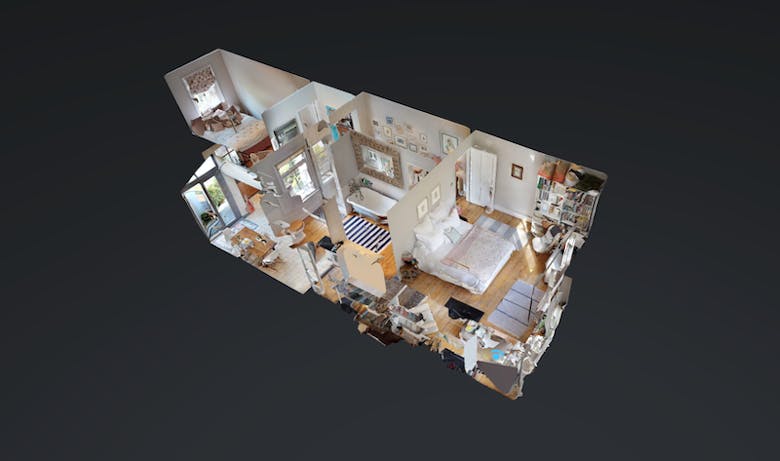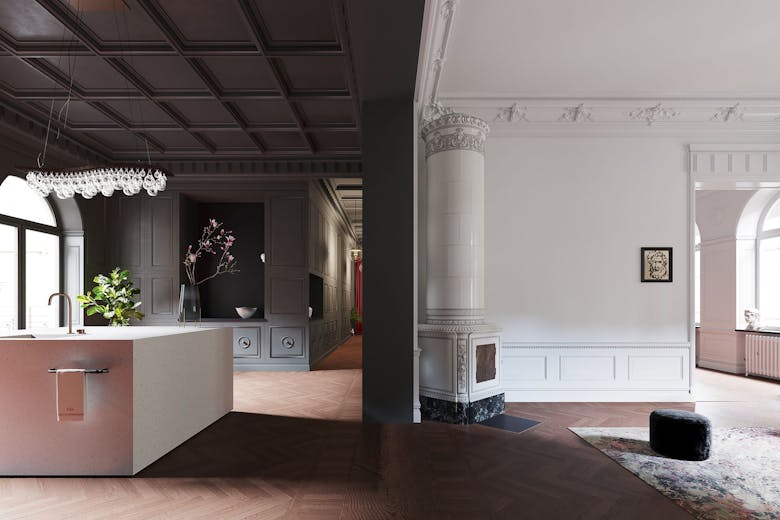After years of watchfulness and tentative progress, the Covid-19 pandemic has forced the property industry – pretty much overnight – to adopt new ways of engaging with clients and customers. Adapting is no longer an option. Here’s a no-nonsense crib sheet for agents and firms venturing into the virtual realm, breaking down the key terms, providers, available tech – and pitfalls to be aware of…
What is a virtual tour?
- The term virtual tour or virtual viewing describes the simulation of an existing location or property, usually composed of a sequence of still images or video that are linked together to create a 360 degree visualisation of an environment or living space.
- It may also use other elements such as floorplans, text or sound.
- The virtual tour is normally accessed on a smartphone, Mac/Ipad or PC and it evokes the experience of moving through a real place without actual travel.
Why virtual viewings are useful
- Virtual viewings have become highly useful sales and marketing tools in light of the latest guidance from the Ministry of Housing and the Law Society on marketing and transaction procedures during the Coronavirus lockdown.
- Developers and estate agents, with sales teams working remotely/from home, can market properties via virtual viewings technology and remote telephone/video calls, and offers can be made and accepted.
- For unoccupied properties or empty new-build homes, once contracts are exchanged, transactions can continue without any delay since there are no existing occupier risks.
- Despite the Coronavirus pandemic buyers and tenants want to view properties, yet stay safe; so virtual viewings are an innovative solution to help meet this demand.
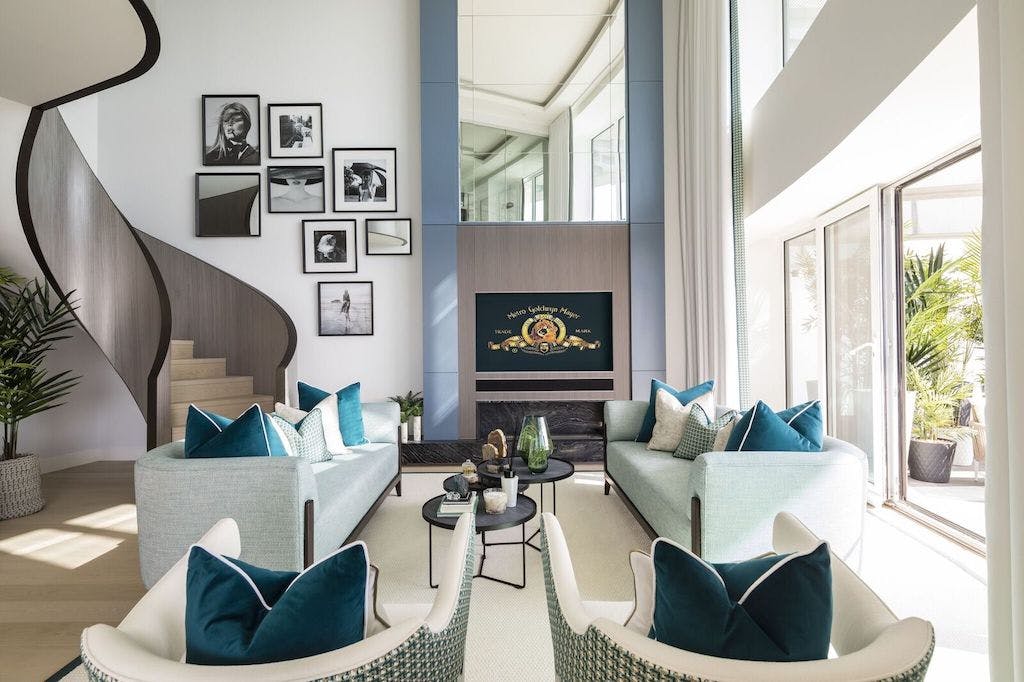
The origins of virtual tours
- In the UK the virtual tour dates back to 1994 when a 360-degree reconstruction of a tour through Dudley Castle in England was created.
- The virtual tour of Dudley Castle was officially opened by HM The Queen and virtual tours then became increasingly popular in the tourism and hospitality industry, providing virtual tours of castles, hotels and historic walks or nature trails.
Virtual tours and the property industry
- In the property industry virtual tours are still in their relative infancy.
- They started in the property industry around 15 years ago when ultra-wide-angle camera lens and computer were used to stitch together photos to create a panoramic image.
- The circular non-rectilinear appearance of the resulting images gave these panoramic lens the nickname ‘fisheye lens’.
- The process was expensive and time consuming and the results were often poor quality and off-putting since the panoramic images didn’t represent the properties very well.
What is the latest technology available?
- The 360-degree virtual tours have really begun to develop in the property industry within last five years.
- The latest technology now allows for a fully interactive virtual viewing that links the viewing screens of the buyer and sales agent and allows the sales agent to control the viewing and provide a buyer with a truly interactive viewing with the buyer able to speak and ask questions of the sales agent in real time, just as they would do in a real physical property tour.
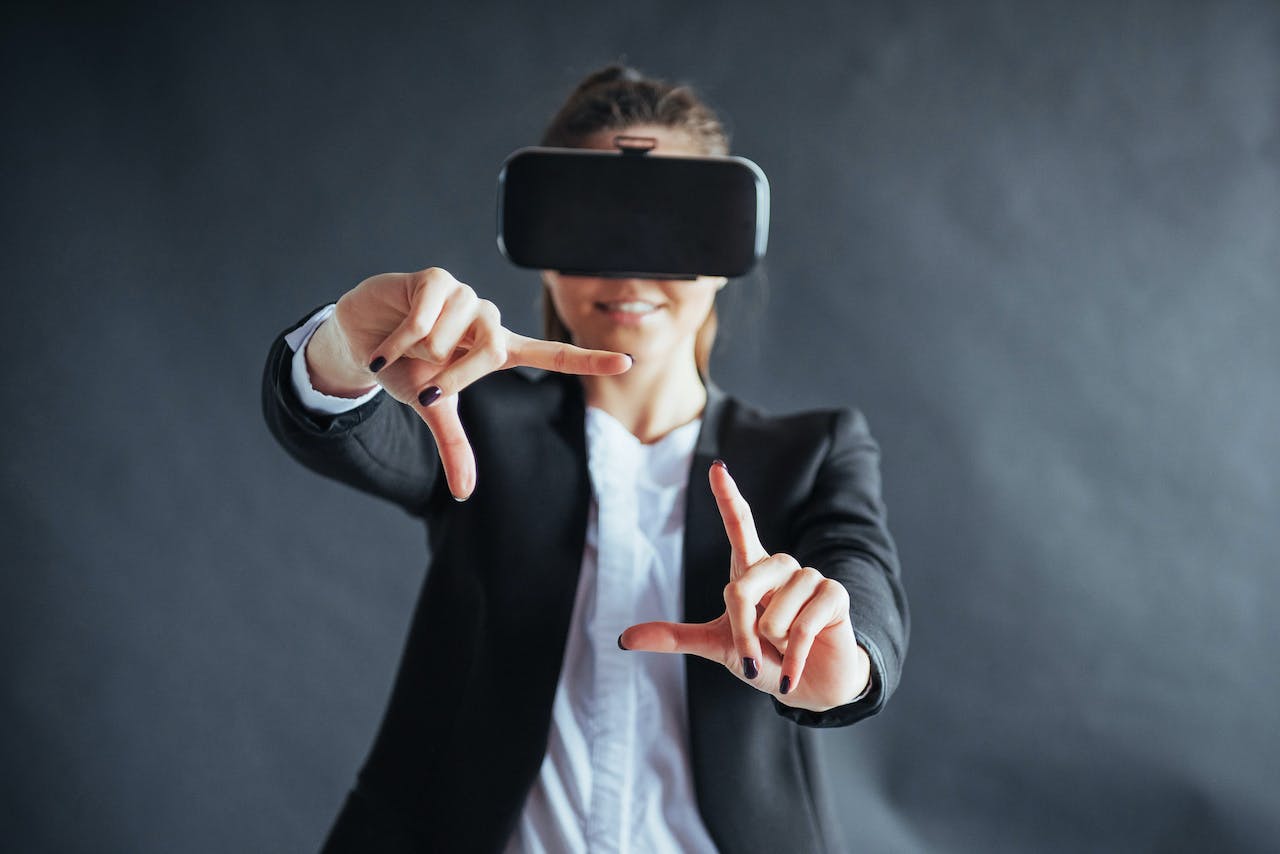
Tour terminology
Video flythrough
- A video flythrough is a tour created by a full motion video of a property.
- Unlike a virtual tour’s wrap-around feel, a video tour is only a linear walk-through of a property.
- A video flythrough can range hugely in quality, from a professionally shot and edited video, to a video produced on an Iphone.
- A video tour is a marketing tool, but it is not a sales tool since it is merely a linear walk-through of a property and there is no real time interaction between the
- sales agent and the buyer/tenant during the viewing.
- In addition, the video does not allow the viewer to stop and focus in on a feature that is of interest to them since the walk-through is pre-recorded and unable to provide changes or interaction during the viewing.
Virtual tour
- A virtual tour is a 360-degree tour of a property created from images fused together on a computer to create a panoramic tour of a property.
- The virtual tour can only be accessed by one person, the viewer, at a time and is not an interactive engagement between the buyer and sales agent.
- A basic virtual tour of this type can be provided to a buyer to view – however this is effectively like a sales agent giving a set of keys to an applicant and letting them go around a property without a guide/sales agent.
- As the sales agent has no input during a basic virtual tour this type of basic tour is a marketing item rather than a sales tool.
Guided virtual viewing
- This is a 360-degree tour of a property where the sales agent is able to link their viewing screen with the buyer’s viewing screen and provide a proper guided tour of a property involving two people who can speak to each other during the tour.
- Guided viewings are both a marketing and sales tool since the sales/lettings agent is able to lead the tour and have direct input.
- Potential buyers/tenants are sent a digital link for the property they are interested in viewing, along with a unique access code which connects the buyer’s screen to that of the sales agent.
- This enables the sales agent to speak to and interact with the buyer/tenant and take them on a professionally guided virtual viewing of the home for sale/rent.
- The sales person is able to converse with the buyer/tenant during the tour and outline all the features and benefits of the property, and answering any buyer/tenant questions during the virtual viewing.
- To access the virtual viewing the buyer can use any smart of PC device including smartphone/i-phone, tablet, laptop or traditional PC, connecting the agent and buyer from anywhere in the world.
- Should the buyer/tenant want a partner, relative, investment adviser or lawyer to join the virtual viewing, this can be arranged, and several people can have connected screens with the sales agent and join the virtual viewing.
Matterport
- Founded in 2011 Matterport is a company that provides a platform to capture, store, share and experience 3D images and models.
- The company’s primary services are Matterport Cameras and Matterport Cloud.
- Matterport Cameras are three key camera types (360 camera, Pro2 RD Camera and the Pro2 Lite 3D Camera that users need to purchase to capture the 3D models – called Matterport Space – and store it in Matterport’s platform.
- The platform is called Matterport Cloud, which is a storage and sharing platform that processes the captured images into Matterport Space.
- Viewers are sent a link to the 3D tour produced, and they can then tour the property.
- The system doesn’t do a full 360-degree view, so you cannot view the ceiling or the floor.
- The system doesn’t allow a sales agent to link with the buyer/tenant, so this offering is virtual tour, not a guided virtual viewing.
Ricoh Theta Cameras
- Ricoh Theta are a line of 360-degree cameras produced by Japanese manufacturer Ricoh, originally founded in 1936.
- The Ricoh Theta 360-degree cameras were first produced in 2013, with the latest models produced between 2016 and 2019.
- The latest models are capable of 360-degree video and photos and are designed to work alongside a smartphone, enabling for live preview and uploading of the captured media.
Fisheye Camera
- Ricoh Theta is a camera with two “fish eye” (named because they look like fish eyes) lenses pointed in opposite directions.
- Therefore one picture is taken with each lens simultaneously, therefore showing a full 360 degree image.
- Because the lens takes such a wide angle, the image is somewhat “stretched” and distorted and is of a lower quality.
- 360-degree cameras with two lenses or more are able to accommodate a full 360-degree angle with two lenses facing each other.
- A camera takes pictures and videos with an angle of just over 180 degrees.
- These are then converted into a 360-degree object using software.
Stereoscopic 3D Camera Rig
- A 3D camera rig is a device for mounting two cameras together to form one 3D-system in order to shoot stereoscopic (three-dimensional-style) images.
- To create stereoscopic depth in photography two slightly different images have to be viewed at the same time, each of them presented to one eye.
- The images have to be photographed in exactly the same moment, therefore it is necessary to shoot with two cameras that are synchronized via a special rig system.
- A 3D camera rig provides the possibility to mount and co-ordinate two cameras, with a horizontal offset and adjustment the cameras in all possible axes.
- A stable rig will create a series of images which can be fused through a computer programme to create a three-dimensional visual tour.
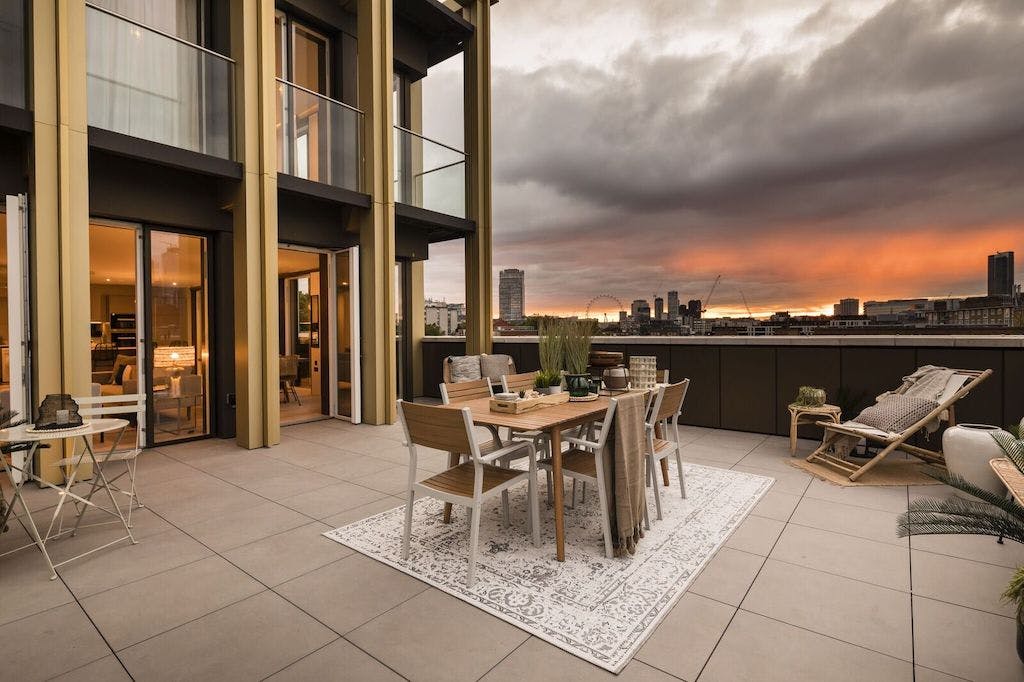
Issues & Pitfalls to be aware of
- The virtual tours/viewings industry is divided between providers who sell the 360 degree camera kits to estate agents and developers; and firms who provide a turn-key service for clients, these full-service firms will go to each property with the 360 degree camera kits and shoot the photos and create and edit the virtual tours for clients, providing them with a completed link to the tour.
- If agents/developers are going to purchase the kits themselves and photograph and edit the tours themselves, they need to be aware that using the 360 degree cameras well takes experience and they need to be skilled at post-production work – this can be time consuming and costly on resources.
- If an agent/developer is going to purchase 360 degree camera kits themselves and do the tours in-house they need to consider the technology, they then use to create and provide the link to a buyer/tenant – ideally, they need to use technology that will enable the sales agent and buyer to connect during the tour – rather than just having a tour which can only be used by the applicant.
- Whether the estate agent/developer does the work in-house or uses a full-service provider to create the virtual tour/viewing the quality of the images/photography is of paramount importance.
- Estate agents and developers need to research the sector carefully and providers in order to ensure that they are not overcharged, they need to look at price versus the quality of the end product, and to also check how the finished tour can be used.
- Security is another key issue – the estate agent or developer needs to ensure that there is an option for the virtual tours to be viewed only under their guidance and therefore cannot be accessed by everybody, just the applicant wanting to tour the property.
Example Full Service Providers
- Full service providers will send a specialist photographer to undertake a 360-degree photoshoot the property and will then use a computer package to link and edit the photos to create a virtual tour.
- The entire process takes on average 24 hours from initial commission to delivering the virtual tour/viewing via a link to the client.
Reevo 360
- Founded in 2018 Reevo 360 provides guided virtual viewings for estate agents and developers using a bespoke IT and camera rig to create a state-of-the-art 360-degree virtual reality interior and exterior views of the property; the system enables the sales agent to interact with the buyer/tenant during the tour.
- Reevo 360 also provides other marketing assets including high quality photography, RICS standards floorplans, videography, drone photography and videography EPCs and CGI renders.
- Reevo 360 uses revolutionary technology linked to a bespoke design camera rig that took 1.5 years to research and develop to create a virtual tour that can link two people viewing the tour – the guided virtual viewings are priced in bundles from £90 per property.
- Potential buyers/tenants are sent a digital link for the property they are interested in viewing, along with a unique access code which connects the buyer’s screen to that of the sales agent.
- The sales agent can take control of both viewing screens and to speak to and interact with the buyer/tenant and take them on a professionally guided virtual viewing of the home for sale/rent.
Focal Agent
- Focal agent provides virtual viewings, videos, photography and floorplans to estate agents and developers.
- The Croydon headquartered firm works with estate agents and photographers across the country.
- The firm also provides digital enhancement services for photography.
NicheCom
-
- Established in 1993 NicheCom provides 3D virtual tours, photoshoots, floorplans and drone photography.
- NicheCom is one of the longest established providers of virtual tours using Matterport 3D showcase technology.
- Operating from its Wokingham head office the business also provides design and print work for firms wanting marketing collateral and property particulars.
- NicheCom uses a network of photographers across the country to provide Matterport based 3D virtual tours of properties for estate agent clients.

Example Kit Providers
- Kit providers are firms which provide the estate agents and developers with the 3D cameras, but the property firms need to shoot and sometimes edit the tours themselves.
Matterport
- Matterport provide 3D cameras and related products to estate agents and developers who then need to shoot and edit the tours themselves or hire a photographer to take and edit the tours.
- Cameras are priced from £2,830 with a tour hosting platform priced at £247 per month and floorplans priced from £13 a floorplan.
Giraffe 360
- Giraffe 360 is a subscription provider for property firms and provides a 360-degree proprietary camera (Model 3 is the latest) which creates photography, virtual tours and floorplans for properties.
- The camera is set up around the property and in each space once activated shoots the rooms automatically.
- The captured images are then merged to create a virtual tour.
- Giraffe 360 provide a camera and charge in bundles from £30 to £99 per property to process the completed shoot.
Eyespy360
- Eyespy360 is another subscription provider for property firms where the estate agent or developer can process and edit the photos themselves or Eyespy360 can do it for an additional fee.
- The cost of processing three virtual tours is £9.99 per month or £29 per month for processing 10 virtual tours.
- This cost excludes the purchase or hire of a 360-degree camera.
- Eyespy360 recommend to clients that they purchase or hire a Ricoh Theta V camera to do the virtual tours which costs £399.00.
Top Tips
- Be clear on what the virtual tour is for – is it marketing? Or is it sales?
- If the requirement is just for marketing, then a video tour or virtual tour may be sufficient; if the requirement is for sales then a guided virtual tour linking sales agent and buyer should be considered.
- A good virtual tour/viewing will aim to represent exactly what the property looks like – it is a realistic tour – and should not be overly enhanced in post production.
- If a virtual tour becomes overly enhanced in post production it runs the risk of no longer accurately represent a physical tour and whilst it might look outstanding a buyer could be disappointed with the reality.
- If an estate agent or developer is using guided virtual viewings it is very important that the sales team practice using the technology.
- Learning to take over and control a buyers/applicants viewing screen takes some practice and the sales agents should spend 2-3 days practicing internally before they do a guided virtual viewing with a real applicant.
- The negotiator who actually visited a property should be used to brief and train the rest of the sales team about the property before the team implement virtual viewings.
Important Note to Readers
This article was written by Daniel Freeman of Reevo 360 as an overview of the virtual viewing market. All prices listed are provided merely as a broad outline guide and are not meant, and should not be taken, to be authoritative as prices agreed with the various full service and kit providers will be subject to the size and scale of the order(s) being placed, which will impact on the prices offered and deals agreed. All readers should contact suppliers directly and do their own direct pricing research and get their own direct quotes, as prices will vary depending on the order being placed.
